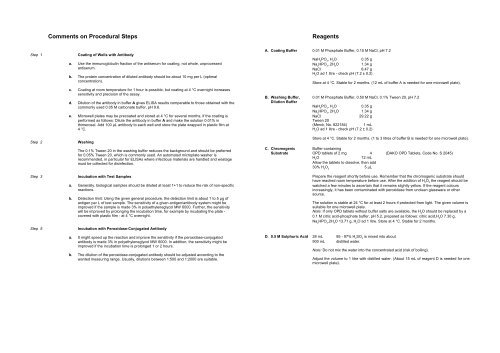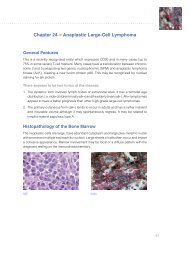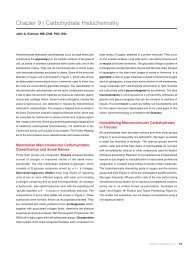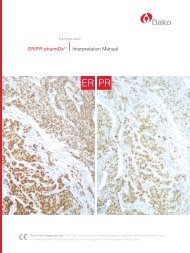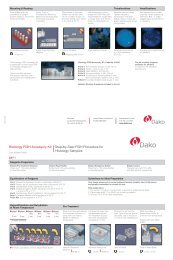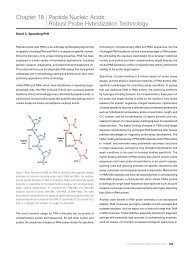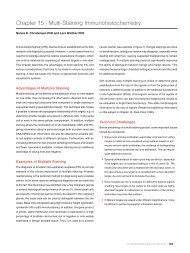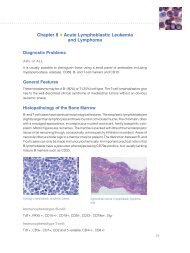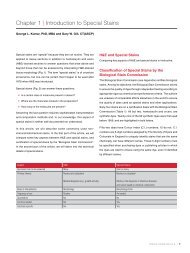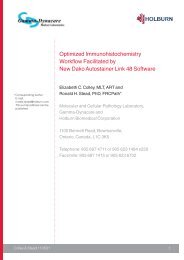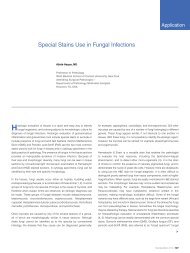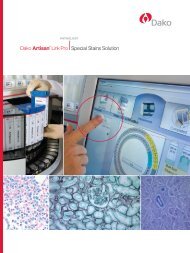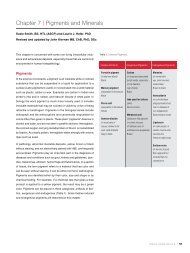General ELISA Procedure - Dako
General ELISA Procedure - Dako
General ELISA Procedure - Dako
You also want an ePaper? Increase the reach of your titles
YUMPU automatically turns print PDFs into web optimized ePapers that Google loves.
Comments on Procedural Steps<br />
Step 1 Coating of Wells with Antibody<br />
Step 2 Washing<br />
a. Use the immunoglobulin fraction of the antiserum for coating, not whole, unprocessed<br />
antiserum.<br />
b. The protein concentration of diluted antibody should be about 10 mg per L (optimal<br />
concentration).<br />
c. Coating at room temperature for 1 hour is possible, but coating at 4 °C overnight increases<br />
sensitivity and precision of the assay.<br />
d. Dilution of the antibody in buffer A gives <strong>ELISA</strong> results comparable to those obtained with the<br />
commonly used 0.05 M carbonate buffer, pH 9.6.<br />
e. Microwell plates may be precoated and stored at 4 °C for several months, if the coating is<br />
performed as follows: Dilute the antibody in buffer A and make the solution 0.01% in<br />
thimerosal. Add 100 µL antibody to each well and store the plate wrapped in plastic film at<br />
4 °C.<br />
The 0.1% Tween 20 in the washing buffer reduces the background and should be preferred<br />
for 0.05% Tween 20, which is commonly used. An automated microplate washer is<br />
recommended, in particular for <strong>ELISA</strong>s where infectious materials are handled and wastage<br />
must be collected for disinfection.<br />
Step 3 Incubation with Test Samples<br />
a. <strong>General</strong>ly, biological samples should be diluted at least 1+1 to reduce the risk of non-specific<br />
reactions.<br />
b. Detection limit: Using the given general procedure, the detection limit is about 1 to 5 µg of<br />
antigen per L of test sample. The sensitivity of a given antigen/antibody system might be<br />
improved if the sample is made 3% in polyethyleneglycol MW 6000. Further, the sensitivity<br />
will be improved by prolonging the incubation time, for example by incubating the plate -<br />
covered with plastic film - at 4 °C overnight.<br />
Step 5 Incubation with Peroxidase-Conjugated Antibody<br />
a. It might speed up the reaction and improve the sensitivity if the peroxidase-conjugated<br />
antibody is made 3% in polyethyleneglycol MW 6000. In addition, the sensitivity might be<br />
improved if the incubation time is prolonged 1 or 2 hours.<br />
b. The dilution of the peroxidase-conjugated antibody should be adjusted according to the<br />
wanted measuring range. Usually, dilutions between 1:500 and 1:2000 are suitable.<br />
Reagents<br />
A. Coating Buffer 0.01 M Phosphate Buffer, 0.15 M NaCl, pH 7.2<br />
NaH 2 PO 4 , H 2 O 0.35 g<br />
Na 2 HPO 4 , 2H 2 O 1.34 g<br />
NaCl 8.47 g<br />
H 2 O ad 1 litre - check pH (7.2 ± 0.2)<br />
Store at 4 °C. Stable for 2 months. (12 mL of buffer A is needed for one microwell plate).<br />
B. Washing Buffer, 0.01 M Phosphate Buffer, 0.50 M NaCl, 0.1% Tween 20, pH 7.2<br />
Dilution Buffer<br />
NaH 2 PO 4 , H 2 O 0.35 g<br />
Na 2 HPO 4 , 2H 2 O 1.34 g<br />
NaCl 29.22 g<br />
Tween 20<br />
(Merck, No. 822184) 1 mL<br />
H 2 O ad 1 litre - check pH (7.2 ± 0.2)<br />
Store at 4 °C. Stable for 2 months. (1 to 3 litres of buffer B is needed for one microwell plate).<br />
C. Chromogenic Buffer-containing<br />
Substrate OPD tablets of 2 mg 4 (DAKO OPD Tablets, Code No. S 2045)<br />
H 2 O 12 mL<br />
Allow the tablets to dissolve, then add<br />
30% H 2 O 2 5 µL<br />
Prepare the reagent shortly before use. Remember that the chromogenic substrate should<br />
have reached room temperature before use. After the addition of H 2 O 2 the reagent should be<br />
watched a few minutes to ascertain that it remains slightly yellow. If the reagent colours<br />
increasingly, it has been contaminated with peroxidase from unclean glassware or other<br />
source.<br />
The solution is stable at 24 °C for at least 2 hours if protected from light. The given volume is<br />
suitable for one microwell plate.<br />
Note: If only OPD tablets without buffer salts are available, the H 2 O should be replaced by a<br />
0.1 M citric acid-phosphate buffer, pH 5.2, prepared as follows: citric acid,H 2 O 7.30 g,<br />
Na 2 HPO 4 ,2H 2 O 13.71 g, H 2 O ad 1 litre. Store at 4 °C. Stable for 2 months.<br />
D. 0.5 M Sulphuric Acid 28 mL 95 - 97% H 2 SO 4 is mixed into about<br />
900 mL distilled water.<br />
Note: Do not mix the water into the concentrated acid (risk of boiling).<br />
Adjust the volume to 1 litre with distilled water. (About 15 mL of reagent D is needed for one<br />
microwell plate).


